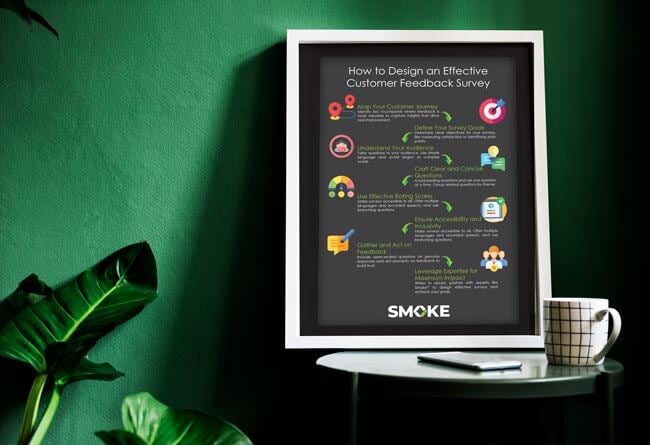Touchpoint Mapping vs Customer Journey Mapping: What’s the Difference?
You’ve probably heard these terms before, but we’ve recently heard them used interchangeably. Now some might argue that this is a mild mistake, but...
2 min read
![]() Smoke Customer Intelligence
:
17 September 2024
Smoke Customer Intelligence
:
17 September 2024

Creating surveys that yields valuable insights is a crucial skill for Customer Experience (CX) managers and professionals. Effective surveys can help you understand customer needs, gauge satisfaction, and identify areas for improvement. This article will guide you through the essential steps and best practices for designing surveys that provide meaningful data and actionable insights.
Begin by mapping out your customer journey to identify key touchpoints where feedback is most valuable. Pinpointing moments that matter to customers will help you understand where and when to survey, ensuring your efforts focus on capturing insights that drive real improvement.
Determine the objectives you want to achieve with your surveys. Whether it’s understanding customer satisfaction, gauging loyalty, or identifying pain points, a clear goal will guide your question design and help you analyse results effectively.
Know who your respondents are. Tailor your questions to your audience's understanding level, avoiding jargon, complex words, or acronyms that might confuse. This approach ensures you get meaningful feedback from all segments of your customer base.
Design questions that are easy to understand and answer. Avoid leading questions that might prompt a particular response. Ask one question at a time to avoid confusion, and group related questions by theme to keep the survey organised and straightforward.
Explain any rating scales used within the survey to avoid ambiguity. Clearly define what each point on the scale represents, allowing respondents to provide accurate and meaningful feedback.
Make your surveys accessible to all customers by offering multiple languages or recorded speech options. Use branching questions to keep the survey relevant to each respondent and include optional questions to prevent survey fatigue. Always provide an opt-out option to respect the customer’s choice.
Include open-ended questions where customers can express their true thoughts and feelings. This verbatim feedback can offer deep insights into customer sentiments. Act on the feedback promptly to demonstrate that you value your customers’ opinions, building trust and loyalty.
Creating effective surveys is an art and a science. If you find it challenging to design surveys that yield actionable insights, consider partnering with experts like Smoke CI. Our team can help you achieve your survey goals with tailored strategies and tools.
Want an easy way to remember these tips? Download our free infographic!

Effective surveys are vital for understanding and improving the customer experience. By mapping out the customer journey, defining clear goals, designing simple and concise questions, ensuring accessibility, and acting on feedback, you can create surveys that truly make a difference. Remember, the key is to keep the survey short, focused, and relevant to achieve maximum engagement and meaningful insights.
Ready to transform your customer feedback into actionable insights? Contact SmokeCI today, and let us help you design surveys that capture the voice of your customer effectively.

You’ve probably heard these terms before, but we’ve recently heard them used interchangeably. Now some might argue that this is a mild mistake, but...

No two businesses are identical. Just like a pair of denim jeans - they might look similar and be called jeans, but each pair has subtle differences...

Antisocial behaviour in council or any housing association can significantly impact residents' quality of life. It's not just a matter of comfort;...